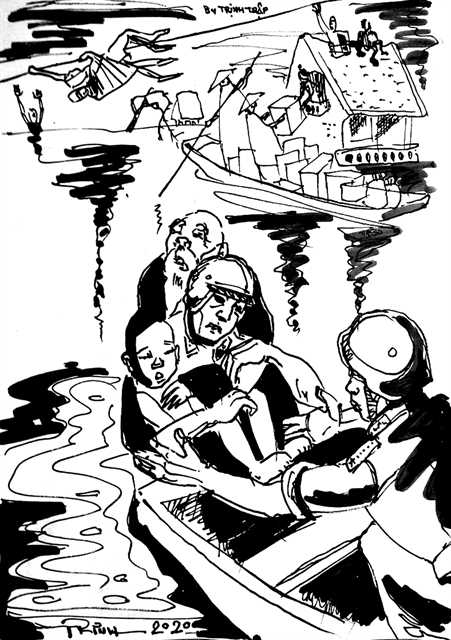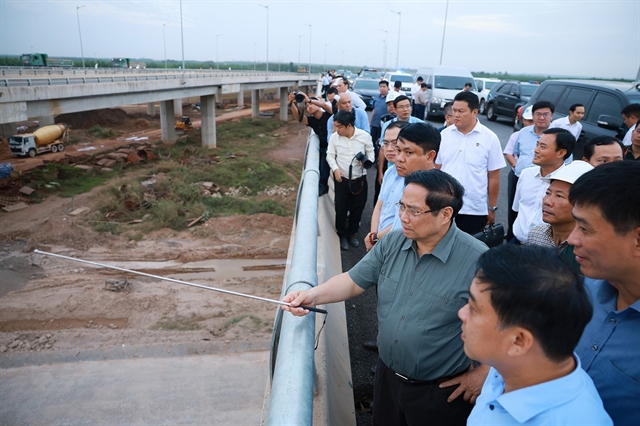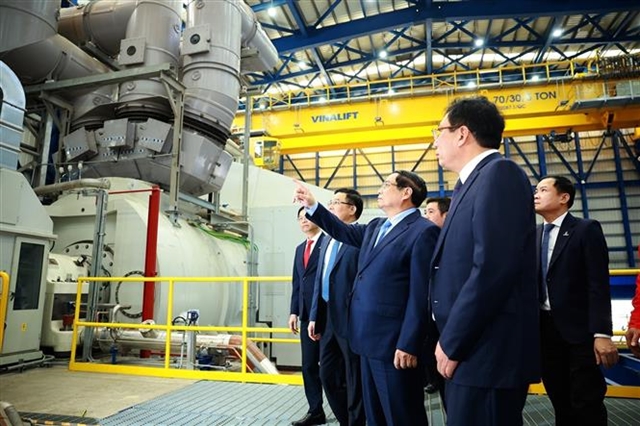 Talk Around Town
Talk Around Town

In times of emergency, Vietnamese people have a knack for reacting quite promptly. They co-ordinate well, communicate well, and set aside any disagreements to work towards a common goal, which in this case is to bring people to safety and provide them with life’s necessities.

|
| Illustration by Trịnh Lập |
by Nguyễn Mỹ Hà
A Vietnamese saying has it that if you help someone in need, even though what you give them may be small, its impact is much greater.
Nearly three months after the second wave of COVID-19 hit the central cities and provinces of Đà Nẵng, Huế, and Quảng Nam, the annual typhoon season has hit that thin strip of land even harder.
The Facebook fanpage of Hà Tĩnh Province ran photos of the local Kẻ Gỗ Reservoir, with a caption reading “Kẻ Gỗ Reservoir at this moment. More than 1,000 cubic metres per second. People downstream, please evacuate. We cannot continue to be reckless.”
In the comments below, my friend’s mother, who visited her hometown in Hà Tĩnh just a fortnight ago, posted, “I visited this reservoir earlier this month, and the water level was so shallow you could see the bottom.”
“Now that it’s about to burst the dam, I’m praying to Buddha to stop the rain,” the 75-year-old wrote.
Photos and alert messages regarding people left at home without help or any assistance close by swamped the fanpage.
One comment on a story about a mother giving birth as she escaped from her flooded home read, “When you’re born in these special circumstances, grow up to be a special person, baby!”
The National Bureau for Weather Forecasting has announced that rains may recede over the next two days. Even so, the Chairman of the Hà Tĩnh Provincial People’s Committee has said that nearly 50,000 people in three districts downstream of the Kẻ Gỗ Reservoir must evacuate.
Dozens of rescue and relief vehicles heading from the north to the central region could move no further along National Highway 1 at one point, and were forced to sit idle as the immediate assistance they could provide was delayed by hours.
A professional rescue team from a swimming and scuba diving club in Hạ Long Bay got close to Hà Tĩnh and were able to reach isolated locations, with directions from on-site rescue teams.
In times of emergency, Vietnamese people have a knack for reacting quite promptly. They co-ordinate well, communicate well, and set aside any disagreements to work towards a common goal, which in this case is to bring people to safety and provide them with life’s necessities.
Lending a hand in difficult times makes people feel good and more than willing to do what’s required.
“Bros in Hoàng Su Phì, maybe we could send some rice to the central region,” exclaimed a young homestay owner in his mid-30s I met on our last trip to the area’s beautiful terraced rice fields.
“Life here is tough,” he went on. “We don’t have cash but we could send a sack of freshly harvested rice. If each household could donate one sack, then the province could send a few tonnes to the central region.”
The local government then got behind the idea, while a transport company volunteered to take the rice down south for free.
It was all such a wonderfully quick and effective joint effort from the grassroots level, initiated by local people and turned into reality by local government.
Those with experience from search and rescue efforts in previous years have sent out tips on what to send in the first wave of aid: instant noodles, clothing, and milk. Yes, milk.
A former journalist with Việt Nam Television who has worked in the rescue and relief programme for years said that milk is the best thing to give at this time, because it doesn’t require a flame and is healthy. Within one day, he rustled up more than 100 cartons for the aid effort.
Right next to hard-hit Hà Tĩnh, neighbourhood teams in Nghệ An cooked chưng cakes, a special treat normally reserved for Tết (the Lunar New Year festival), to send to relief centres full of people who hadn’t eaten in days.
A lot of such aid normally rushes in to flooded areas during the first week, but when the water recedes people need rice, not instant noodles. They also need medication, because diseases spread quite easily in such conditions.
At this week’s opening ceremony of the National Assembly in Hà Nội, deputies stood for a minute’s silence to remember the people and soldiers who had perished, one of whom was NA deputy Nguyễn Văn Man. The deceased was army major general who lost his life during a search and rescue mission in the landslides and floods that have ravaged the central region for the past two weeks.
The latest news from the national weather bureau is that the dam at the Kẻ Gỗ Reservoir remains intact, and official records show that water levels in Hà Tĩnh have been falling significantly for two days.
But another tropical low has formed in the East Sea and is poised to strike. Extreme caution very much remains the order of the day, and any action taken must follow guidelines and instructions from local governments.
Friends living overseas have messaged me asking if there’s a single office that handles all donations for all disasters. Do we have one? VNS




